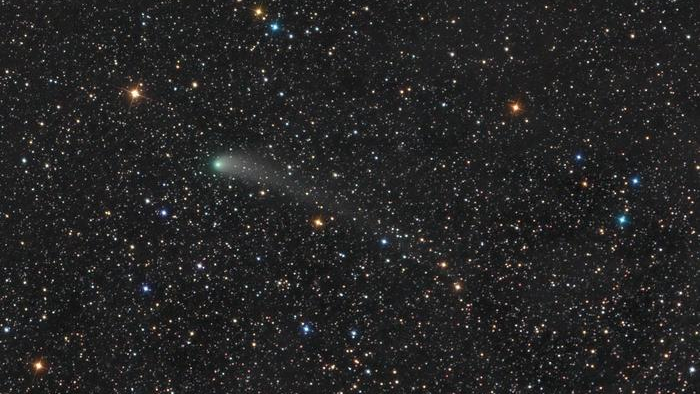
Researchers are calling on amateur astronomers to help photograph the broken tail of a comet on track to pass by Earth this spring. The comet, named C/2021 S3 PanSTARRS, will safely pass by Earth at about the same distance the sun sits from our planet. And as the comet passes through our solar system, its tail may be battered by powerful solar winds, composed of charged particles coming from the sun. With this in mind, researchers from the University of Reading have turned to the public to help study the comet.
"What we are expecting to see may look rather unusual. When we talk about comets, people often think of a large, bright sphere followed by a long thin tail," Sarah Watson, a researcher from the University of Reading, said in a statement. "The comet we are observing may look different as its tail could 'detach' as it is buffeted by solar winds."
As comets travel toward the inner solar system, the heat of the sun causes ice on the object to melt, which creates a trailing cloud of gas and dust, also known as the comet's tail. Comets are often referred to as "cosmic windsocks," given the fact their tail can indicate the direction and strength of the nearby solar wind. For example, a detached or wobbling tail would indicate an increase in solar wind activity near the comet, according to the statement.
Related: Spectacular comet views from Earth and space
Therefore, a compilation of C/2021 S3 PanSTARRS images could help researchers better understand solar wind conditions local to the comet and, as it approaches Earth, forecast solar storms that may affect our planet.
"We need lots of timed photos of the comet to build up a picture of its journey through our solar system," Watson said. "This is a fantastic opportunity for amateur astronomers to get out their telescopes, capture a truly spectacular cosmic moment and make a big contribution to some important science."
C/2021 S3 PanSTARRS came into view in mid-February and will be visible in the night sky through the end of March. It will become easier to see in the coming weeks as it appears further away from the sun and stays above the horizon in the night sky for longer. Although the comet is too dim to be seen with the naked eye, it can be easily spotted using binoculars or a telescope.
"Stargazers will need a small telescope to which they can attach a camera or a camera with a big lens to capture the comet," according to the statement from the university. "Photographers should look out for a fuzzy object to identify the head of the comet and a bright dash behind it to identify the tail."
If you're hoping to capture photos of C/2021 S3 PanSTARRS, our guide on how to view and photograph comets can help. You can also use our best cameras for astrophotography and best lenses for astrophotography guides to prepare for capturing the fleeting comet.
Photos can be sent to University of Reading researchers at s.r.watson@pgr.reading.ac.uk, including the image location and time so that researchers can understand the comet's journey and potentially detached tail. The best photos received as part of the study will be sent to the British Astronomical Association to be archived, according to the statement.
Charged particles in solar wind can be energetic enough to impact our planet’s magnetosphere, which can disrupt GPS and satellites, ground-based electric power grids, and, in some cases, cause radio blackouts on Earth. Therefore, photos of C/2021 S3 PanSTARRS will also help improve space weather forecasts and better protect Earth.
Editor's note: If you snap an amazing photo of a Geminid meteor or any other night-sky sight and you'd like to share it with Space.com for a story or image gallery, send photos, comments and location information to spacephotos@space.com.







